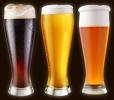
Greetings everyone! We hope you had a great weekend are excited about this latest installment in your continuing Beerducation. Today we will be covering our next ingredient, the spicy, floral and vital hop.
Back in times of yore before refrigerators and beer cozies, preservation was rather difficult when it came to food and beverages and beer was no exception. For years brewmasters of old (and we assume wizards too), experimented with a variety of ingredients to try and solve this problem. After much trial, error, and more trial and touch more of error the mighty hop came to their rescue!
The hop, a close relative of cannabis sativa (we here at Beer Quest have no idea what that is), not only behaved as a natural preservative, but also infused the beer with many other pleasing qualities, such as herbal, floral and spicy flavors and aromas and a crisp bitterness (measured in IBUs, a.k.a., International Bittering Units) to balance out the sweetness from the malt. Grown around the world, the varieties of hops are countless, though most fall within the categories Continental, British and American.
Continental (or European hops) often have spicy, earthy characteristics and a staple in European beer styles. A notable example is the Pilsner with distinct Saaz hops. British hops often come across in floral and herbal aromas and Fuggles and East Kent Goldings are behind many of the flavors in ESBs and Brit Pale Ales. American hops are often piney and citrusy (grapefruit is common) and many an American craft brewer loves to hop up big IPAs and Barleywines with Cascade, Centennial and other American hop varieties.
When it comes to the actual brewing process the hops are added in after the mashing while the wort is boiling in a process known as a hop schedule. Most beers boil for an hour and during this hour the hops are added at different times which is a huge factor in what the hops will contribute to the beer. If they’re added at the beginning of the boil the oils break down they add more bitterness to the beer. Those added towards the end of the boil are not in long enough to completely break down and add strong aromas to the beer. And those added around the middle will give strong flavors. Some beers, particularly those big hoppy IPAs, will have hops added during fermentation to enhance aroma in a process known as dry hopping.
Now that you’ve learned some of the basics take a moment to thank this wonderful plant that has made it possible for your beer to stay fresh and crisp. That’s something I know I’ll drink to. Stay tuned for our next class of your continuing Beerducation in which we will cover the wonderful alchemical little organism that makes wort into beer: yeast! In the meantime, enjoy these late summer days and see you around.

No comments:
Post a Comment